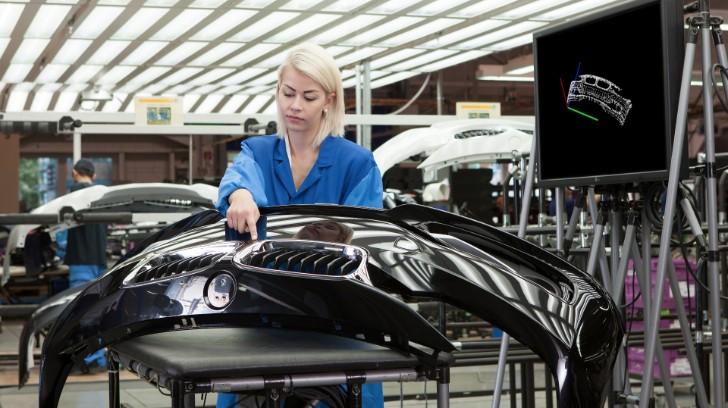Another industrial revolution might’ve just been started in BMW’s Landshut plant last week with the introduction of a non-contact gesture detection system that helps workers quality-check the company’s products.
Using technology similar to the one Microsoft introduced for its Kinect devices on Xbox 360 consoles, the automated gesture detection system from BMW helps shorten the time needed to check every component of a car while making the worker’s life easier at the same time.
The system is currently just a pilot project developed only at the Landshut plant but it could go mainstream in the near future. Right now, it’s being used only to check the front bumpers. Before being mounted, workers check the quality of the part. Each deviation from the standard has to be recorded in a system and evaluated.
In the past, in order to do so, workers had to insert the flaw into the database by using a standalone PC. Sometimes, that PC would not be nearby, therefore the worker had to walk a considerable distance to reach it and then introduce the data, wasting time and going through a lengthy process.
However, with the new technology, developed in collaboration with the Fraunhofer Institute in Karlsruhe, the process is simplified.
‘The system recognizes the interaction between the person and the bumper,’ explains the BMW Group’s responsible project coordinator Ramona Tremmel. ‘A wiping motion across the component marks the bumper as flawless. If a worker points their finger at a faulty section of the bumper, however, cameras register this gesture.’ The program then evaluates it and stores the entry.
The system uses two 3D cameras fitted above the workplaces. They have infrared sensors that radiate a grid of points onto the part at all times, comparing it to a 3D model stored in the system already. When the worker points to the bumper, the coordinates change because they are reflected by the hand and that’s how the system knows where the problem is and stores it.
Apart from saving a lot of time and effort for the workers, the system is also standalone, not needing additional devices like eyewear or microphones, also speeding up the process.
“The gesture interaction is simple and easy to understand and can be applied intuitively, without requiring extra training time. People do not have to walk to other workstations anymore and can concentrate better on their work,” added Tremmel.
The pilot phase has been completed successfully and preparations for the introduction of this system inside all BMW plants have begun.
The system is currently just a pilot project developed only at the Landshut plant but it could go mainstream in the near future. Right now, it’s being used only to check the front bumpers. Before being mounted, workers check the quality of the part. Each deviation from the standard has to be recorded in a system and evaluated.
In the past, in order to do so, workers had to insert the flaw into the database by using a standalone PC. Sometimes, that PC would not be nearby, therefore the worker had to walk a considerable distance to reach it and then introduce the data, wasting time and going through a lengthy process.
However, with the new technology, developed in collaboration with the Fraunhofer Institute in Karlsruhe, the process is simplified.
‘The system recognizes the interaction between the person and the bumper,’ explains the BMW Group’s responsible project coordinator Ramona Tremmel. ‘A wiping motion across the component marks the bumper as flawless. If a worker points their finger at a faulty section of the bumper, however, cameras register this gesture.’ The program then evaluates it and stores the entry.
The system uses two 3D cameras fitted above the workplaces. They have infrared sensors that radiate a grid of points onto the part at all times, comparing it to a 3D model stored in the system already. When the worker points to the bumper, the coordinates change because they are reflected by the hand and that’s how the system knows where the problem is and stores it.
Apart from saving a lot of time and effort for the workers, the system is also standalone, not needing additional devices like eyewear or microphones, also speeding up the process.
“The gesture interaction is simple and easy to understand and can be applied intuitively, without requiring extra training time. People do not have to walk to other workstations anymore and can concentrate better on their work,” added Tremmel.
The pilot phase has been completed successfully and preparations for the introduction of this system inside all BMW plants have begun.


